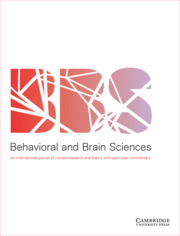Crossref Citations
This article has been cited by the following publications. This list is generated based on data provided by Crossref.
Molenaar, Peter C.M.
and
Lo, Lawrence
2013.
Embodiment and Epigenesis: Theoretical and Methodological Issues in Understanding the Role of Biology within the Relational Developmental System - Part B: Ontogenetic Dimensions.
Vol. 45,
Issue. ,
p.
21.
Molenaar, Peter C. M.
2014.
Dynamic Models of Biological Pattern Formation Have Surprising Implications for Understanding the Epigenetics of Development.
Research in Human Development,
Vol. 11,
Issue. 1,
p.
50.


Target article
Behavior genetics and postgenomics
Related commentaries (19)
A call for an expanded synthesis of developmental and evolutionary paradigms
A developmental science commentary on Charney's “Behavior genetics and postgenomics”
A straw man's neogenome
Biology trumps statistics in the postgenomic era
Clinicians learn less and less about more and more until they know nothing about everything; researchers learn more and more about less and less until they know everything about nothing: Discuss
Epigenetic regulation of brain-derived neurotrophic factor: Implications in neurodevelopment and behavior
Estimating the actual subject-specific genetic correlations in behavior genetics
From gene activity to behavior (and back again)
Gene-independent heritability of behavioural traits: Don't we also need to rethink the “environment”?
Heritability estimates in behavior genetics: Wasn't that station passed long ago?
Is behavioral genetics ‘too-big-to-know’ science?
Is genomics bad for you?
Neogenomic events challenge current models of heritability, neuronal plasticity dynamics, and machine learning
Non-Mendelian etiologic factors in neuropsychiatric illness: Pleiotropy, epigenetics, and convergence
Postgenomics and genetic essentialism
Preventing a paradigm shift: A plea for the computational genome
The fate of heritability in the postgenomic era
The history of the nature/nurture issue
Twin and family studies are actually more important than ever
Author response
Humans, fruit flies, and automatons